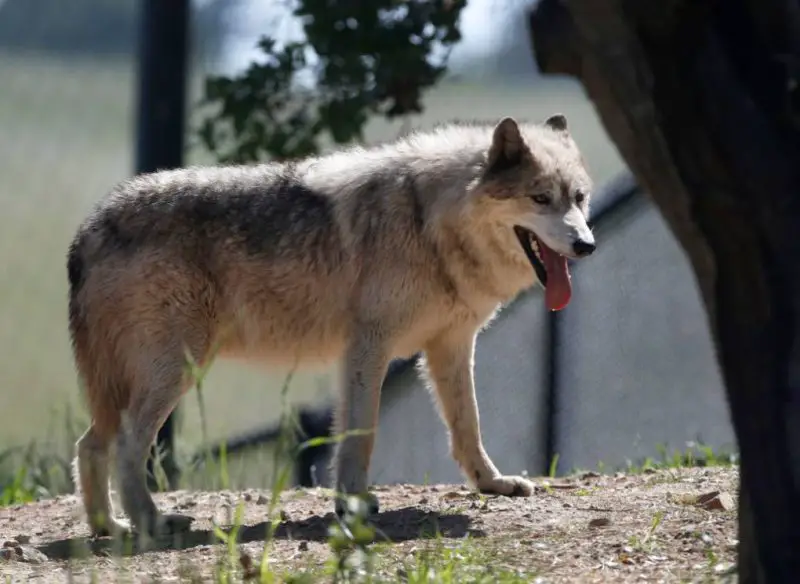The gray wolf (Canis lupus) was once a prominent predator throughout many regions of North America, including California. However, by the late 19th and early 20th centuries, gray wolves had nearly vanished from the state due to hunting, habitat loss, and human encroachment.
It wasn’t until 2011 that a lone wolf, famously known as OR-7, was spotted in California, marking the species’ return after more than 90 years of absence. This remarkable event sparked renewed interest in the conservation and study of gray wolves in the state, highlighting their role as apex predators in California’s ecosystems.
Types of Gray Wolves in California

Gray wolves in California mainly belong to the Northwestern subspecies (Canis lupus occidentalis). This subspecies is recognized as one of the largest gray wolf types in North America, known for its robust body size, adaptability, and strong hunting abilities. While California does not yet host established packs, individual wolves and transient packs are increasingly observed migrating from neighboring states like Oregon and Nevada.
Identification and Physical Characteristics
Gray wolves are distinguished by their thick fur, which can range from gray to brown or even white, often featuring a darker line along the back. They have large heads, long muzzles, upright ears, and piercing eyes that enhance their hunting capabilities. Adult gray wolves typically weigh between 45 and 80 kilograms (100–175 pounds) and measure 1.2 to 1.5 meters (4–5 feet) in length, including their bushy tails. Their strong legs and lean, muscular build make them highly efficient predators over long distances.
Behavior and Social Structure
Gray wolves are highly social animals that live in structured packs. Each pack is usually led by an alpha pair, accompanied by other adult males and females and their offspring. Pack members cooperate in hunting, raising pups, and defending their territory. Gray wolves are known for their strategic hunting techniques, often pursuing prey such as deer, elk, and smaller mammals over extended distances. They rely heavily on teamwork and communication to successfully capture food.
Wolves are primarily crepuscular, being most active during dawn and dusk. Vocalizations, especially howling, serve as critical tools for communication within packs and to warn intruders. A wolf’s howl can travel up to 10 kilometers under optimal conditions, helping maintain cohesion among widely dispersed pack members.
Habitat and Distribution
Historically, gray wolves inhabited California’s dense forests, grasslands, and mountainous regions. Following their reappearance in 2011, wolves have slowly begun to re-establish themselves, primarily in the northern part of the state. Wolves migrating from Oregon and Nevada have been spotted in Siskiyou, Modoc, and Shasta counties, areas that provide suitable prey, forest cover, and limited human disturbance.
Gray wolves require expansive territories that can range from 200 to 500 square kilometers for a single pack. These areas offer enough prey and denning sites to support their populations. Forested valleys, foothills, and riparian corridors are particularly favored for denning and hunting.
Reproduction and Life Cycle
Gray wolves typically breed once a year, with the mating season occurring between January and March. After a gestation period of approximately 63 days, the alpha female gives birth to a litter of four to seven pups. Wolf pups are born blind and helpless, relying entirely on their mother and other pack members for care. Both parents, as well as subordinate pack members, contribute to feeding, protection, and teaching essential survival skills.
Pups grow rapidly, opening their eyes within two weeks and beginning to explore the den around three to four weeks of age. By the fall, they are usually ready to join the pack on hunts, learning crucial strategies from older wolves. This cooperative rearing ensures high survival rates despite the dangers of predation and environmental challenges.
Hunting and Diet
Gray wolves are apex predators with a diet that primarily consists of large ungulates such as deer, elk, and occasionally wild pigs. They also hunt smaller mammals, birds, and carrion when large prey is scarce. Wolves are known for their endurance and cooperative hunting, often chasing prey for several miles to exhaust it before making the kill.
Their hunting success relies on communication, strategy, and physical coordination. Wolves often take turns chasing, flanking, and isolating weaker individuals within a herd, showcasing their intelligence and teamwork. Even in California, where wolves are still rare, observations suggest they retain these complex hunting behaviors.
Fun Facts About Gray Wolves
Gray wolves have fascinated humans for centuries due to their intelligence, social bonds, and mysterious presence in the wild. Unlike many other predators, wolves form lifelong bonds within their packs, demonstrating loyalty and cooperation. OR-7, also known as “Journey,” became famous not only for being the first wolf spotted in California in decades but also for traveling over 4,000 kilometers across multiple states, highlighting the species’ remarkable ability to traverse long distances.
Additionally, wolves play a crucial ecological role. By controlling prey populations, they help maintain the health of ecosystems, prevent overgrazing, and support biodiversity. Their return to California symbolizes both a conservation success story and the resilience of wildlife.
Gray Wolf Population in California
The gray wolf population in California is still very small and primarily consists of transient individuals migrating from neighboring states such as Oregon and Nevada. Since the return of OR-7 in 2011, sightings have gradually increased, with a few confirmed packs establishing territories in the northern counties, including Siskiyou, Modoc, and Shasta.
California’s wolves are currently considered a recovered but fragile population, as human activity, livestock conflicts, and habitat fragmentation continue to pose threats. Wildlife agencies closely monitor these wolves through GPS collars, camera traps, and field surveys to track their movements, reproductive success, and overall population growth.
Although the number of wolves in California remains low compared to other western states, their gradual establishment marks an important milestone in conservation. Each new pup or pack formation represents hope for the long-term recovery of gray wolves in the state, ensuring that they can once again play their critical ecological role as apex predators.
Top Locations to Watch Gray Wolves in California
For those eager to observe gray wolves, northern California offers the best opportunities. Counties such as Siskiyou, Modoc, and Shasta provide the forests, valleys, and remote areas that wolves prefer. Sightings are still rare, but wildlife enthusiasts and researchers often focus on regions bordering Oregon, where established packs provide dispersing individuals into California. Trail cameras, guided wildlife tours, and early morning excursions in these regions increase the chances of witnessing these elusive predators.
While spotting wolves requires patience and respect for their natural behavior, the experience of encountering one of North America’s most iconic predators in the wild is unforgettable. Conservation programs and monitoring efforts continue to track wolf populations, helping ensure their safe return to California’s landscapes.
Conclusion
The gray wolf’s reemergence in California reflects both the resilience of nature and the importance of wildlife conservation. These remarkable predators, with their complex social structures, strategic hunting, and ecological influence, are slowly reclaiming their historic habitats. Observing gray wolves in the wild offers insight into the delicate balance of ecosystems and the enduring spirit of one of North America’s most fascinating carnivores. As research and conservation continue, the story of California’s gray wolves serves as a powerful reminder of how humans and wildlife can coexist in shared landscapes.
FAQs About Gray Wolves in California
What types of gray wolves are found in California?
California is primarily home to gray wolves belonging to the Northwestern subspecies (Canis lupus occidentalis). These wolves are large, adaptable, and often migrate from neighboring states like Oregon and Nevada.
How can I identify a gray wolf in the wild?
Gray wolves have thick fur that can be gray, brown, or white, with a darker line along their back. They have large heads, long muzzles, upright ears, and piercing eyes. Adult wolves typically weigh 45–80 kg and measure 1.2–1.5 meters long, including the tail.
Where do gray wolves live in California?
Gray wolves prefer remote forests, mountainous regions, and grasslands. In California, they are mostly found in the northern counties such as Siskiyou, Modoc, and Shasta, often near state borders where they migrate from Oregon.
What do gray wolves eat?
Gray wolves are apex predators and primarily hunt large ungulates such as deer and elk. They also eat smaller mammals, birds, and carrion when necessary. Wolves hunt cooperatively, using strategy and endurance to capture prey.
How do gray wolves communicate?
Wolves communicate using vocalizations such as howls, body language, and scent marking. Howling helps pack members locate each other and warn intruders, with sounds capable of traveling up to 10 kilometers.
How do gray wolves reproduce?
Gray wolves mate once a year, typically between January and March. After a gestation period of about 63 days, the alpha female gives birth to a litter of four to seven pups. Both parents and other pack members care for the pups.
Are gray wolves dangerous to humans?
Gray wolves are naturally wary of humans and attacks are extremely rare. Most interactions are non-aggressive, especially in California where wolf populations are still small and elusive.
What is the best time to see gray wolves in California?
Wolves are most active during dawn and dusk. Early morning or late evening trips in northern California’s forests and valleys increase the likelihood of sightings, though wolves remain elusive and sightings are rare.
Why are gray wolves important for the ecosystem?
Gray wolves help maintain ecological balance by controlling prey populations, preventing overgrazing, and supporting biodiversity. Their presence influences the behavior of herbivores, which indirectly benefits plant communities and other wildlife.






